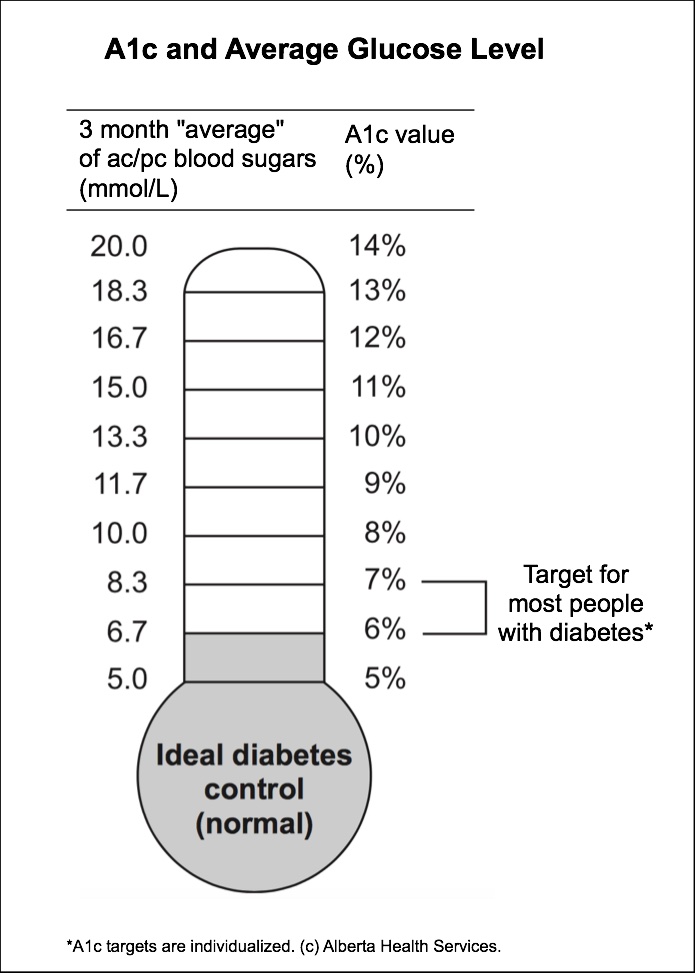The hemoglobin A1c is a key topic of discussion for educators and clients. This three month measure of glucose control is highly correlated with diabetes complications. Reviewing the significance of A1c values with patients helps them build conviction to maintain or increase diabetes management behaviors.

- The A1c (HbA1c, glycosylated or glycated hemoglobin) is a non-fasting blood test that reflects glycemic control over the previous 2-3 months, with the last month's control having a greater impact (50% of the value comes from the most recent 30 days). It is used to determine long-term glucose control in diabetes or to diagnose diabetes and prediabetes. HbA1c does does not reflect daily glucose fluctuations.
- The test is a measure of the amount of glucose attached to hemoglobin in the red blood cells. Red blood cells have a lifespan of about 3 months in healthy individuals. Hence, this glycemic test is often referred to as a “three month average” blood sugar. Various charts exist to equate A1c level to an apporiximated average blood glucose level.
- The test is routinely repeated every 3-6 months in those with diabetes or monthly in those with diabetes in pregnancy.
- Target A1c values in diabetes are individualized but often 7% or less in those who aren't pregnant. This reflects premeal readings of 4-7 mmol/L and pc readings 5-10 mmol/L. Some conditions can result in invalid A1c results.
- An estimated HbA1c (eA1C) is automatically calculated in software used by continuous glucose monitoring devices and requires at least 14 days of data. Using the most recent 4 weeks of data for the eA1c can inform patients if changes to diabetes management are working. The lab A1c and eA1c may differ depending on many factors. In some cases, the eA1c may be the preferred metric if the patient is known to have factors that impact A1c.
2. Why Does A1c Matter?
The A1c level is highly correlated with diabetes complications. Key landmark trials indicate that any sustained drop in A1c can represent a reduction in the risk of complications. These results listed below can help build conviction in patients to lower A1c.
- UKPDS: In the type 2 diabetes trial United Kingdom Prospective Diabetes Study each one percent point decrease in A1c (e.g., 9% to 8%), was associated with a 35% reduction in the risk of microvascular complications. See this quick video update on the most recent summary of data from UKPDS regarding macrovascular outcomes. Video - UKPDS Legacy Effects: The Importance of Treating Hyperglycemia Early Oct 10, 2022 Update on UKPDS
- DCCT: In the type 1 diabetes study Diabetes Control and Complications Trial the intensive treatment group had a 2% lower A1c than the control group (7% vs 9% respectively). This lower A1c was associated with a 60% reduction in the risk for microvascular complications (nephropathy, retinopathy, neuropathy) after an average of seven years.
- EDIC: The DCCT cohort continued to be followed in the Epidemiology of Diabetes Interventions and Complications study for a total of 30 years. It's important to point out that when the DCCT ended, the A1c of the intensive group as a whole rose above 7% and the A1c of the control group as a whole dropped. Sometime after the study, both groups averaged similar A1c values in the years following the DCCT. However, the seven years of initial lower A1c values of the intensive treatment group was associated with a 32% reduction in major vascular events (MI, stroke, CVD death) even three decades later. Early glucose control was determined to have protective long-term benefits in type 1 diabetes. These later effects of A1c on health outcomes has been referred to as "metabolic memory."
The A1c can help in the assessment of self-glucose monitoring results. E.g. May’s A1c has been 8.5% the last two times, yet her home glucose testing is showing results of 5-7 mmol/L before meals. Mary may be asked to have her meter checked for accuracy, to test after meals, to consider short-term or long-term use of a glucose sensor or to do other tasks to help troubleshoot.
3. What Affects A1c?
An A1c test can be unreliable for diagnosing or monitoring diabetes in people with certain conditions that are known to interfere with the results. See the table below or view at Diabetes Canada.

4. A1c Resources & Teaching Analogies
- See the Topics Catalogue for HbA1c handout, video and glucose wands
- Teaching analogies shared by educators in Diabetes Workshops for Professionals.
- The A1C is like a batting average in baseball; it tells you about a player’s overall performance, not about the specific high or low periods.
- A1c tests are like candy apples. Just like syrup sticks to apples, sugar in the blood sticks to hemoglobin in red blood cells. The higher the concentration of sugar in the blood, the more sugar sticks